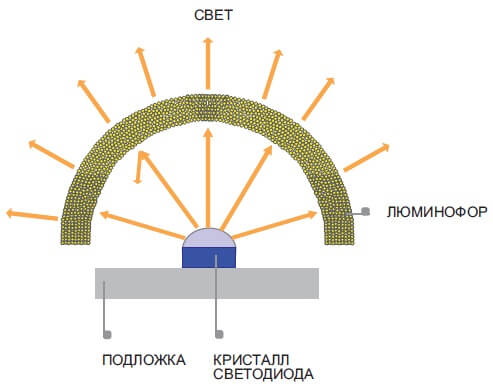The remote phosphor technology

The remote phosphor technology.
The remote phosphor technology is a way to obtain white light as a result of interaction of the radiation in blue or blue LEDs with the remote at some distance from the crystal phosphor.
Description:
The remote phosphor technology is a way to obtain white light as a result of interaction of the radiation in blue or blue LEDs with the remote at some distance from the crystal phosphor.
The remote phosphor technology involves the design svetoprozrachnye element made of optically transparent material (plates or articles have a more complex spatial form) with deposited on the surface or embedded in the bulk phosphor and the mixing chamber, coated with material with a high reflectance (more than 0.95).
In other words, the uniqueness of the technology of remote phosphor is that the phosphor is dispensed not on blue pkg directly, but on the separate cap which acts as the diffuser.

As light sources used in semiconductor crystalsthat emit light with a frequency of 450 nm.
The choice of color and composition of the phosphor plate determines the temperature of emission and color rendering index.
Remote phosphor allows in most cases to do without a diffuser.
Marred plate gives a uniform light spot with uniform light distribution without gaps of brightness, the most natural to the human eye, while the canvas led lamp “fill light” with many individual white led lights creates at the remote plane of the uneven illumination in the form of “ripples” that causes discomfort and irritation of view.
Advantages:
– long service life of the phosphor and led. Service life more than 70,000 hrs (8 years continuous operation), taking into account the degradation of the phosphor
– reliability. The remote phosphor technology protects phosphor from degradation or damage, thus, ensures reliable operation and long service life,
– creates new opportunities for designers of lighting fixtures and lighting systems
– greatly reduces the brightness of the emitting surface,
– provides previously unattainable performance capabilities and features
– wide beam angle. The ability to match the three-dimensional shape of the plate with the phosphor allows to produce lamps with a beam angle up to 300-330o,
– absence of discreteness of the emitting element. In contrast to conventional led lights where each led is an individual light source, lamp, produced by technology, remote phosphor, forms a single light spot, which is most naturally perceived by the human eye and does not irritate it
– freedom of choice the temperature of the glow. The remote phosphor technology provides a wide range of light temperature (2700-5000 K),
– high efficiency. By reducing heat loss between the led and the phosphor crystals, as well as the lack of a lens increase light efficiency is 20-30% compared with conventional white LEDs.



